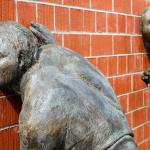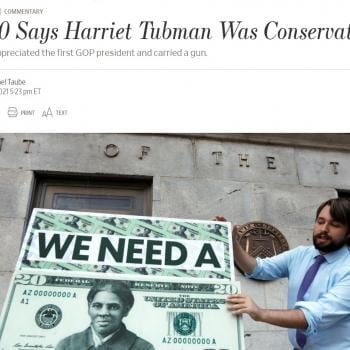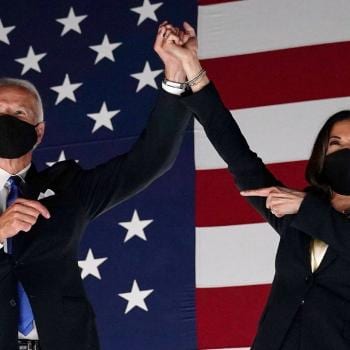I recently came upon a Fox News article by an F. H. Buckley. The article was titled Why ‘No Hate Here’ signs are actually pretty hateful. Knowing there was no way this would end well, I decided to take a look.
My walks with my dog take me to a quiet off-street, with middle-class houses made expensive because they’re inside the Beltway. Their owners are mostly youngish attorneys who work as assistant-deputy-director-somethings in some government department or other.
Two of the homes feature “No Hate Here” signs.
What’s up with that, you might wonder. This is a peaceful, upscale, decidedly un-diverse neighborhood. The greatest threat to suburban peace is the lone homeowner whose lawn looks a tad overgrown. There’s nothing to suggest that anyone is a racist or bigot. So again: What’s going on?
Buckley describes the neighborhood where he walks his dog as “peaceful, upscale, [and] decidedly un-diverse,” and then adds that “there’s nothing [about the neighborhood] to suggest that anyone is a racist and a bigot.” This leaves me curious. How exactly does a neighborhood with racists in it advertise itself? Does Buckley think all racists fly Confederate flags? And why should we start with the assumption that a white person isn’t racist, rather than the assumption that they are racist?
Racism, after all, usually does not look like Nazi tattoos or Ku Klux Klan costumes. It also does not have to involve hate. Racism can consist of subtle—even unconscious—biases. Racism can be believing stereotypes. Racism can play a role in any number of day-to-day decisions, including the decision to to live in a “decidedly un-diverse neighborhood.”
To be sure, I’m not saying that everyone who lives in a “decidedly un-diverse neighborhood” is racist (except to the extent that every white person is). All I’m saying is that I need an explanation for Buckley’s racism meter. How does “peaceful, upscale, decidedly un-diverse neighborhood” translate into “no sign of racism here, thank you very much”?
Buckley turns to dissecting what he believes are reasons for the “No Hate Here” signs:
Someone came up with the label “virtue signaling” to describe the psychological impulse behind these signs. The idea is that people who put them up want to tell you how noble they are. But that doesn’t sound right. Virtue-signalers aren’t in any way in doubt about their own virtue. What they really want to do is signal how depraved others are.
It’s about vice signaling, not virtue signaling.
A couple of people on the block are Trump supporters. Those signs are likely meant for them. There’s no interaction between the two groups, and the signs are meant to keep it that way.
Yep, we’re through the looking glass.
I live in an area where “Hate Has No Home Here” signs are displayed in numerous yards. At their core, these signs are not about virtue signaling or about vice signaling. They’re about signaling to oppressed groups that this is a place where they are welcomed, accepted, and loved.
It’s about the Syrian refugee girl who walks by the signs on the way to school. It’s about the African American mother who passes them on the way to the park with her sons. It’s about the undocumented Hispanic father who drives by the signs on his way to work.
Now, yes, if the neighborhood is as un-diverse as Buckley says it is, there may be no Syrian refugee girls, African American mothers, and undocumented Hispanic fathers to see these signs. But that doesn’t make the statement less worth making. People who put up these signs are identifying themselves as supporters of marginalized groups, for all their neighbors to see. It’s not about saying “heh hey heh, that’ll show them.” It’s about saying, “hey, this is me.”
But Buckley says it’s vice signaling—without any desire to actually ask any of them, of course—and Buckley is not keen on vice signaling. In fact, for Buckley, it’s vice signaling that is at the root of our current societal divide.
A couple of years back there used to be Fourth of July street picnics there. But the shindigs haven’t happened the last couple of years, and I don’t think I’ll see them again soon. Vice signaling breaks up communities, and there’s a lot of it today.
Jee golly. I’ve been looking at this all wrong! It’s the No Hate Here signs that are dividing neighborhoods, not the fact that some people voted for a racist bigot white nationalist demagogue who is now threatening to deport Vietnam War refugees. It couldn’t possibly be that some Americans are horrified so horrified by a president who shouts racist slogans and calls the press “the enemy of the people” that they see anyone who voted for him in a new light! Nope. Not at all. Must be the signs.
(And this is all without mentioning Republicans wholesale reversal of efforts to stop climate change, or their constant promises to repeal the Affordable Healthcare Act and thus deprive millions of Americans of healthcare.)
Buckley’s logic here is baffling and backwards and many, many more things, but his line of reasoning is worth being aware of nonetheless—because if this rhetoric is in Buckley’s article, it’s likely all over the right-wing echo chamber.
Buckley, by the way, says that “vice signaling” is an attempt to displace “liberal guilt” over, well, basically ruining the country. According to Buckley, liberals have “permitted our schools to descend to Third World standards” (if so, this makes me feel downright positive about the educational progress in the Third World), and they’ve “supported an immigration system that imported economic immobility”—I’m still having trouble dissecting that, but I’m guessing Buckley believes the canard that immigration is bad for the economy (it’s not) or bad for American workers (it isn’t).
There’s one more thing of note in Buckley’s rather rambling article, though: he argues that the same processes involved in “vice signaling” are the motivation behind the transgender rights movement.
When the Supreme Court legalized gay marriage, there were no great protests from social conservatives. What is curious, however, is how social liberals turned on a dime to take up transgender rights. After their victory, they immediately took up the cause of a vanishingly tiny number of Americans, the better to blame their opponents. In the permanent cultural wars against conservatives, there’s always one more river to cross.
I have a question. Actually, I have many questions.
Social conservatives spent decades and more fighting gay marriage—and any other rights for gay and lesbian individuals. I’m not sure what Buckley means when he says that “there were no great protests from social conservatives” after Obergefell. Perhaps he means that social conservatives didn’t blow anything up. That is true. They’ve been promising over since Obergefell that they’re going to find a way to get the Supreme Court to overturn it, however—and without the Supreme Court’s decision in Obergefell, gay marriage would still be illegal across much of the U.S.
Furthermore, there’s an argument to be made that social conservatives, and not liberals, started what Buckley calls “the transgender wars.” They’re the ones who started up with the bathroom bills, after all.
But let’s look at the core of Buckley’s argument: that liberals use social issues to sew division, paint their opponents as bad people, and make themselves think they’re better than anyone else. Even if that were true—if liberal support for LGBTQ rights were opportunistic—conservatives could solve the issue in a jiffy by also supporting LGBTQ rights. Easy, right? If they did that—if everyone supported LGBTQ rights—the issue would cease to be a political wedge.
The fact that conservatives have refused to do this and prefer to spend their time fighting LGBTQ rights suggests that there may actually be something here—an actual need for an LGBTQ rights movement—beyond creating a political wedge issue.
Let’s return to Buckley, as he finishes:
What these examples have in common is vice signaling. I can’t see inside their hearts, but what I do know is that the people with their “No Hate” signs sow more division than they do comity. It’s also clear that this constant slicing and dicing of the American people along lines of race, sex and gender makes it that much harder to talk about the common good.
When Buckley says “the common good,” by the way, he means the common good for white men. “Things were great, until we started talking about everyone else!” he insists (this is my paraphrase, but I think it’s a pretty good one).
Also, “how dare you keep talking about what a mean person I am!” is a terrific response to “I think what you’re doing is mean and I want you to stop.” Apparently, saying “hey, could you please stop putting children in cages” is what sews devision—not, you know, putting children in cages. And if Buckley is so against “slicing and dicing” the American people “along lines of race, sex and gender,” he might start by telling Trump to stop talking smack about specific racial groups.
And finally, this:
And if you’re a conservative, how should you respond? Not by being defensive. Instead, tell them you have nothing to apologize for. Tell them to look into their own souls.
Buckley is truly without any self-awareness at all.
I have a Patreon! Please support my writing!















